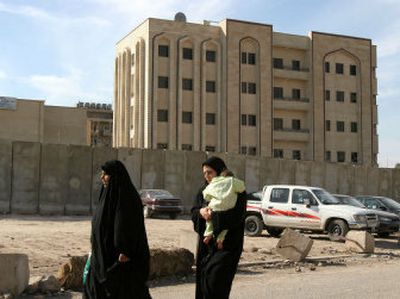Scores of Iraqis taken in mass abduction

BAGHDAD, Iraq – Dozens of assailants wearing Iraqi police commando uniforms and masks kidnapped scores of people from a Higher Education Ministry office in a highly coordinated raid Tuesday morning, witnesses said.
The gunmen, armed with AK-47s and U.S.-made grenade launchers, stormed the five-story downtown Baghdad building in broad daylight and searched it room by room, randomly detaining people along the way, according to education officials and witnesses.
To assist in their getaway, the abductors cordoned off Nidal Street, only a few blocks away from city hall, with more than 30 trucks and armored sport utility vehicles. The trucks did not have license plates, witnesses said, but many did have high-caliber machine guns mounted in their back beds.
Eyewitnesses gave various estimates of the number of kidnap victims but most said at least 70 were taken. The large-scale operation, which witnesses said took only a matter of minutes, was among the biggest and most audacious kidnapping episodes yet in a city where abductions for financial or sectarian reasons have become routine.
In some cases, victims have eventually been released after ransom was paid or have yet to be found. But in many incidents, tortured and handcuffed bodies are all that have later turned up on Baghdad’s streets.
Kidnappings by men in police uniforms have become among the most feared because relatively few victims have returned alive.
Interior Ministry spokesman Abdul Kareem Khalaf said that five senior police officials were detained and interrogated following the kidnappings, including the police chief in charge of the Karada neighborhood in southeast Baghdad where the incident took place. Khalaf declined to say whether it was believed the officials were directly involved, but said that they were, at the very least, negligent for allowing the abductions to occur.
“They could have reported to us that this raid took place,” Khalaf said. “These people who raided that building are not policemen at all, they are just criminals.”
Khalaf said that 20 of the captives, among them Sunni Arabs, Shiites and Christians, were hastily freed because of checkpoints set up by the Interior Ministry. “We closed more than 20 neighborhoods in East Baghdad and cut them off. They had to throw some of the people out of their cars so they wouldn’t get caught,” Khalaf said.
His account of captives being freed could not be independently verified.
Those taken included 17 security guards stationed at the facility, the Scholarship and Cultural Relations Directorate of the Higher Education and Scientific Research Ministry. Also abducted were ministry employees and visitors who had business in the building. The raiders separated men from women, locked the men together in a daisy-chain with plastic flexicuffs and loaded them into vehicles at gunpoint. While no women appear to have been taken hostage, “they beat some of the women,” said a witness who gave his name as Abu Aya.
The kidnappers drove off in a crackle of gunfire, according to Basil Ismael Khateeb, a spokesman for the Higher Education Ministry. “The attackers drove ministry vehicles and opened fire in the air to clear the way for them just like official convoys,” he said.
According to three abductees who were later released, the kidnappers “asked the detainees about their names and their residential areas while beating them on their heads,” Khateeb said.
Interior Ministry spokesman Khalaf declined to say whether he thought a Shiite militia group was involved, saying that the answer to that question could jeopardize the Interior Ministry’s investigation.
Eyewitness estimates of the number of captives ranged as high as 150. Traffic and patrol officers stationed nearby did not interfere, according to witnesses.
The mass kidnapping followed a series of police attacks on the directorate building during the last two months, according to witnesses. Bullet holes and shattered windows mar the building, evidence of several past shootouts.
A guard stationed at a small hospital behind the higher education building said security men at the directorate and police engaged in a 90-minute gunbattle only a week ago. The guard, who identified himself as Abu Hassan, surmised that Tuesday’s attack was payback. Gunfire was minimal during the raid and several witnesses said that the building’s guards did not resist the large force.
Although the kidnap victims included Shiite Muslims and Sunni Arabs, Sunni leaders claimed that the raid was a sectarian attack. Sunnis dominate the Higher Education Ministry.